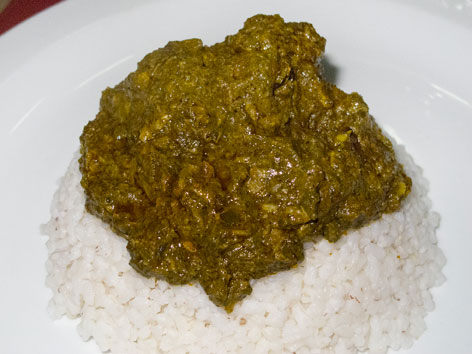Ethiopian Chicken Stew (Doro Wett)
Ethiopia
amantour

guides you to the best local dishes & drinks in
125+ cities. See map now



.jpg) Going somewhere and wish you could take all of a city’s Eat Your World info with you? With EYW’s Kindle and City Guides, you can! Don’t miss out on any local foods or drinks during your next trip.
Going somewhere and wish you could take all of a city’s Eat Your World info with you? With EYW’s Kindle and City Guides, you can! Don’t miss out on any local foods or drinks during your next trip.
EYW wants your food photos!

EYW wants your food stories!
Hey guys I am a traveler who loves to explore different places around the world. I often visit outside of Canada, So whenever I have to travel around the world I always book my flight tickets from the... Read more
<< back to foods in Sierra Leone

What: To the uninitiated, Sierra Leone’s ubiquitous plasas, or palaver sauces—the name given to a variety of dishes in which green leaves are boiled and cooked with oil (usually red palm oil, but sometimes coconut or groundnut oil), hot chilies (called “peppers” here), onion, meat and/or fish, and ever-present stock cubes (i.e., Maggi), served over rice—will seem interchangeable. But we are lumping them together here for convenience’s sake only: Each is actually prepared in a different manner, and has a distinct taste. Cassava leaf (pictured) is pounded and shredded, and typically added to the pot before the meat or fish. (Sweet) potato leaf is sliced up and thrown in after the meat, so it’s cooked less and retains more of a chewy al dente-ness. Crain crain (a.k.a. krain krain/jute leaves/draw soup) is stemmed, cut finely, boiled, and cooked generally to death, so its texture is (intentionally) slimy. And the leaf known as “green” is cut the biggest; you can still decipher and taste the leaf itself. Confused? If you spend just a few days in this country—or elsewhere in West Africa, including Ghana, Gambia, Nigeria, and Liberia, where they’re also common—you’ll likely become intimate with all of the plasas. It’s good chop!
Good to know: Some of these plasas, particularly cassava and potato leaf, are traditionally made with some additional ingredients, according to What’s Cooking Today, by Muriel Emekunle Davies, one of very few published cookbooks on Sierra Leonean cuisine. Groundnut (peanut) paste or okra—both acting as thickeners—and broad beans are among the common add-ins. Moreover, provided the book’s mention of Maggi cubes as an alternative ingredient, we can guess what might have been used here before the Nestlé giant arrived in town: ogeri, which is fermented sesame seeds, or sounbareh, the fermented, roasted, ground seeds of the African locust tree (also called kainda in Krio). (Source here. Read more about the ubiquitous use of Maggi bouillon cubes in West African cooking on our blog.)
Where: Cassava leaf is often heralded as the tastiest of the plasas, and we agree after trying it at Freetown’s long-running Balmaya (078-919750; 32B Main Motor Rd., Congo Cross), an airy restaurant with a lovely veranda and an attached high-end African art gallery. But some credit is due the chef here, who takes pains to cook with fresh ingredients (read: no Maggi cubes), use the superior (and pricier) local country rice, and cut back, at least a little, on the bitter, red palm oil. Prices are higher here than at typical food shacks around the country, but quality follows suit.
When: Mon-Sat, 9am-10pm
Good to know: Cassava leaf is most typically served on Mondays; potato leaves on Tuesdays; crain crain on Thursdays. Balmaya doesn’t necessarily follow this schedule, but many restaurants across the country will.
Order: Cassava-leaf stew (Le30,000), when available, cooked to perfection here with brisket. The tender beef and shredded leaf meld into one tasty, spicy vegetal pile over hearty country rice, which is light years’ better than the imported white stuff found nearly everywhere else.
Alternatively: In Freetown we also liked Jakkah’s Restaurant (030-328-113/033-328-113; 4 George St., map), where the delicious potato-leaf stew was made with goat meat and white rice; and we’ve heard the beckoning Come for Lunch (no phone; near the Lumley roundabout, map) is a reliable local bet. Moving further south along the gorgeous Freetown Peninsula’s coastline (though you’ll probably take the longer eastern route around, until the main road is completed), the terrific cooks at community eco-venture Tribewanted (232-78290578 or 232-78738583; John Obey beach, map) regularly serve plasas in addition to other great Salone lunch dishes, always over country rice—they offer one chop per day, so call ahead if you want to know which (or, much better: plan to stay at least one night there). Á la carte prices are similarly high, as at Balmaya, but quality and company is excellent, and you cannot beat the beachside setting (meals are included for overnight guests).
Along the eastern highway toward Bo, the restaurant at Moyamba Junction, Fakunya Chiefdom Canteen (map), usually has some plasas on offer at dirt-cheap prices (Le4,000, or just over US$1); our crain crain there was properly oily and slimy, with meat and broad beans in the mix.
©2025 Eat Your World, LLC - All Rights Reserved